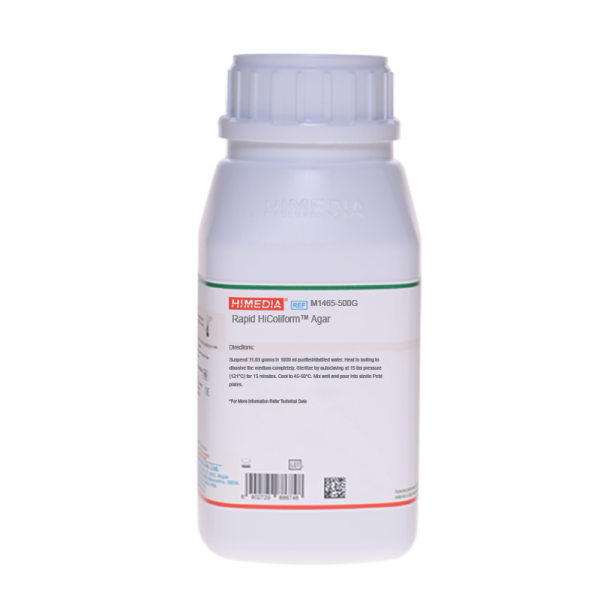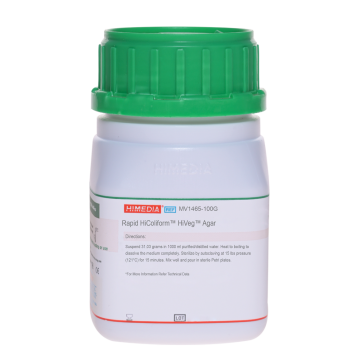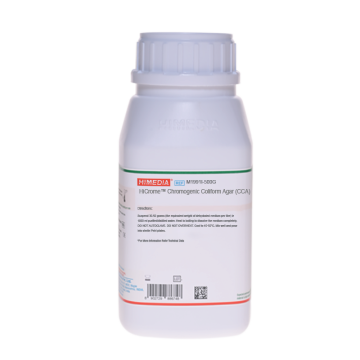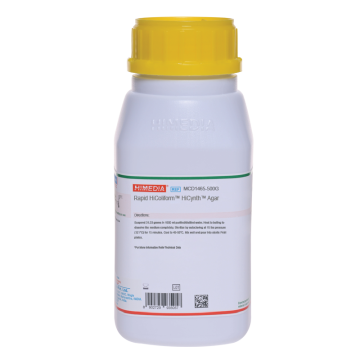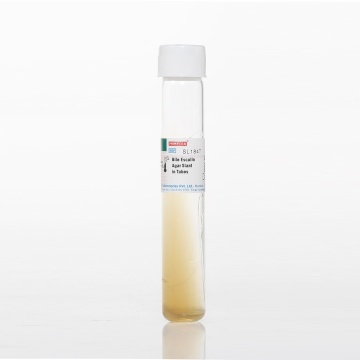 Your enquiry has been submitted
Your enquiry has been submitted
Rapid HiColiform™ Agar
Recommended for detection and confirmation of Escherichia coli and total coliforms on the basis of enzyme substrate reaction from water samples using a combination of chromogenic and fluorogenic substrate.
Composition**
| Ingredients | g / L |
|---|---|
| Peptone, special | 5.000 |
| Sodium chloride | 5.000 |
| Sorbitol | 1.000 |
| Dipotassium hydrogen phosphate | 2.700 |
| Potassium dihydrogen phosphate | 2.000 |
| Sodium lauryl sulphate | 0.100 |
| Chromogenic substrate | 0.080 |
| Fluorogenic substrate | 0.050 |
| IPTG (1-Isopropyl-β-D-1-thiogalactopyranoside) | 0.100 |
| Agar | 15.000 |
Final pH ( at 25°C): 6.8±0.2
**Formula adjusted, standardized to suit performance parameters
Directions
Suspend 31.03 gram in 1000 ml purified/distilled water. Heat to boiling to dissolve the medium completely. Sterilize by autoclaving at 15 lbs pressure (121°C) for 15 minutes. Cool to 45-50°C. Mix well and pour into sterile Petri plates.
Principle And Interpretation
The Rapid HiColiform™ Agar is modification of LMX Broth described by Manafi and Kneifel (1). Rapid HiColiform™ Agar is used for the simultaneous detection of total coliforms and Escherichia coli. This media is useful for the detection and confirmation of Escherichia coli and total coliforms in water samples on the basis of chromogenic and fluorogenic substrates (1-8).
Special peptone which is rich in tryptophan content, provides essential growth nutrients and is useful for the simultaneous detection of indole production. Sorbitol provides the carbon source. The phosphate salts provide buffering action for rapid growth of coliforms. Sodium lauryl sulphate makes the medium selective by inhibiting accompanying microflora, especially the gram-positive organisms. The fluorogenic substrate, is split by enzyme ß-D-glucuronidase, which is specifically found in Escherichia coli. The reaction is indicated by a blue fluorescence under UV light. The presence of total coliforms is indicated by a blue-green colour of the colonies due to the cleavages of the chromogenic substrate. IPTG amplifies enzyme synthesis and increases the activity of ß-D-galactosidase. To confirm presence of E. coli, add 2-3 drops of Kovacs reagent over the suspected colony. The colony turns red within 2 minutes in case of positive reaction.
Type of specimen
Food samples; Water samples.
Specimen Collection and Handling
For food samples, follow appropriate techniques for sample collection and processing as per guidelines (9). For water samples, follow appropriate techniques for sample collection, processing as per guidelines and local standards.(10) After use, contaminated materials must be sterilized by autoclaving before discarding.
Warning and Precautions
Read the label before opening the container. Wear protective gloves/protective clothing/eye protection/face protection. Follow good microbiological lab practices while handling specimens and culture. Standard precautions as per established guidelines should be followed while handling specimens. Safety guidelines may be referred in individual safety data sheets.
Limitations
- 97% of the E.coli strains are ß-D-glucuronidase positive, however few strains may show negative fluorescence.
- Further biochemical and serological test needs to be carried out for confirmation.
Performance and Evaluation
Performance of the medium is expected when used as per the direction on the label within the expiry period when stored at recommended temperature.
Quality Control
Appearance: Cream to yellow homogeneous free flowing powder
Gelling: Firm, comparable with 1.5% Agar gel
Colour and Clarity of prepared medium: Light yellow coloured, clear to slightly opalescent gel forms in Petri plates
Reaction: Reaction of 3.1% w/v aqueous solution at 25°C. pH : 6.8±0.2
pH: 6.60-7.00
Cultural Response
Cultural characteristics observed after an incubation at 35-37°C for 18-24 hours.
| Organism | Inoculum (CFU) | Growth | Colour of medium/Colony | Fluorescence (under uv) | Indole production |
|---|---|---|---|---|---|
| # Klebsiella aerogenes ATCC 13048 (00175*) | 50-100 | luxuriant | blue-green | negative reaction | negative reaction |
| Escherichia coli ATCC 25922 (00012*) | 50-100 | luxuriant | blue-green | positive reaction | positive reaction |
| Klebsiella pneumoniae ATCC 13883 (00097*) | 50-100 | luxuriant | blue-green | negative reaction | negative reaction |
| Salmonella Typhimurium ATCC 14028 (00031*) | 50-100 | luxuriant | yellow | negative reaction | negative reaction |
Key : *Corresponding WDCM numbers. # Formerly known as Enterobacter aerogenes
Storage and Shelf Life
Store between 15-25°C in a tightly closed container and the prepared medium at 2-8°C. Use before expiry date on the label. On opening, product should be properly stored dry, after tightly capping the bottle in order to prevent lump formation due to the hygroscopic nature of the product. Improper storage of the product may lead to lump formation. Store in dry ventilated area protected from extremes of temperature and sources of ignition Seal the container tightly after use. Product performance is best if used within stated expiry period.
Disposal
User must ensure safe disposal by autoclaving and/or incineration of used or unusable preparations of this product. Follow established laboratory procedures in disposing of infectious materials and material that comes into contact with sample must be decontaminated and disposed of in accordance with current laboratory techniques (2,3).
Reference
- Hahn G. and Wittrock E., (1991), Acta Microbiologica Hungarica 38(3-4):265-271.
- Isenberg, H.D. Clinical Microbiology Procedures Handbook 2nd Edition.
- Jorgensen, J.H., Pfaller, M.A., Carroll, K.C., Funke, G., Landry, M.L., Richter, S.S and Warnock., D.W. (2015) Manual of Clinical Microbiology, 11th Edition. Vol. 1.
- Manafi. M. and Kneifel W., (1989), Zbl. Hygiene and Umweltmedizin ,189:225-234.
- Manafi M., (1990), Forum Stadte-Hygiene 41:181-184.
- Manafi M., (1991), Ernahrung / Nutrition, 15, Nr. 10.
- Manafi M. and Kneifel W., (1991), Acta Microbiologica Hungarica 33(3-4):293-304.
- Manafi M., Kneifel B. and Bascon S., (1991), Microbiol. Rev., 55:335-348.
- Salfinger Y., and Tortorello M.L. Fifth (Ed.), 2015, Compendium of Methods for the Microbiological Examination of Foods, 5th Ed., American Public Health Association, Washington, D.C.
- Lipps WC, Braun-Howland EB, Baxter TE,eds. Standard methods for the Examination of Water and Wastewater, 24th ed. Washington DC:APHA Press; 2023.
| Product Name | Rapid HiColiform™ Agar |
|---|---|
| SKU | M1465 |
| Product Type | Regular |
| Physical Form | Powder |
| Origin | Animal |
| Packaging type | HDPE |
| References | 1.Hahn G. and Wittrock E., (1991), Acta Microbiologica Hungarica 38(3-4):265-271.2.Manafi. M. and Kneifel W., (1989), Zbl. Hygiene and Umweltmedizin 189:225-234.3.Manafi M., (1990), Forum Stadte-Hygiene 41:181-184.4.Manafi M., (1991), Ernahrung / Nutrition, 15, Nr. 10.5.Manafi M. and Kneifel W., (1991), Acta Microbiologica Hungarica 33(3-4):293-304.6.,,Manafi M., Kneifel B. and Bascon S., (1991), Microbiol. Rev., 55:335-348. |
| Customized Product Available | No |



